A Cisco FTD device is running in transparent firewall mode with a VTEP bridge group member ingress interface. What must be considered by an engineer tasked with specifying a destination MAC address for a packet trace?
An engineer is working on a LAN switch and has noticed that its network connection to the mime Cisco IPS has gone down Upon troubleshooting it is determined that the switch is working as expected What must have been implemented for this failure to occur?
What is the difference between inline and inline tap on Cisco Firepower?
Which CLI command is used to control special handling of clientHello messages?
A company wants a solution to aggregate the capacity of two Cisco FTD devices to make the best use of resources such as bandwidth and connections per second. Which order of steps must be taken across the Cisco FTDs with Cisco FMC to meet this requirement?
While integrating Cisco Umbrella with Cisco Threat Response, a network security engineer wants to automatically push blocking of domains from the Cisco Threat Response interface to Cisco Umbrella. Which API meets this requirement?
An administrator is optimizing the Cisco FTD rules to improve network performance, and wants to bypass inspection for certain traffic types to reduce the load on the Cisco FTD. Which policy must be configured to accomplish this goal?
Which report template field format is available in Cisco FMC?
An engineer is reviewing a ticket that requests to allow traffic for some devices that must connect to a server over 8699/udp. The request mentions only one IP address, 172.16.18.15, but the requestor asked for the engineer to open the port for all machines that have been trying to connect to it over the last week. Which action must the engineer take to troubleshoot this issue?
Drag and drop the configuration steps from the left into the sequence on the right to enable external authentication on Cisco FMC to a RADIUS server.
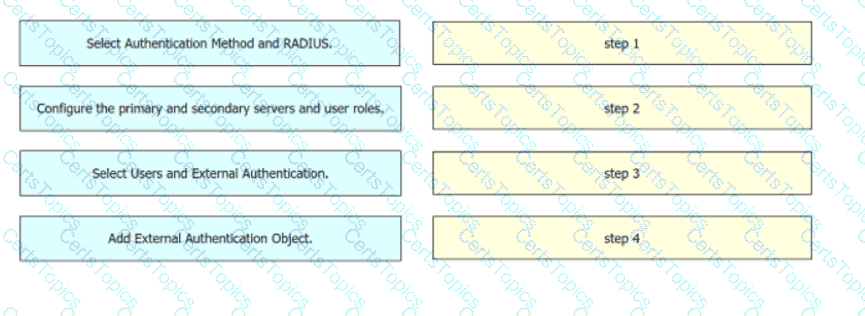
An engineer must configure email notifications on Cisco Secure Firewall Management Center. TLS encryption must be used to protect the messages from unauthorized access. The engineer adds the IP address of the mail relay host and must set the port number. Which TCP port must the engineer use?
An engineer is troubleshooting application failures through a FTD deployment. While using the FMC CLI. it has been determined that the traffic in question is not matching the desired policy. What should be done to correct this?
Which two actions can be used in an access control policy rule? (Choose two.)
When deploying a Cisco ASA Firepower module, an organization wants to evaluate the contents of the traffic without affecting the network. It is currently configured to have more than one instance of the same device on the physical appliance Which deployment mode meets the needs of the organization?
An engineer is troubleshooting an intermittent connectivity issue on a Cisco Secure Firewall Threat Defense appliance and must collect 24 hours worth of data. The engineer started a packet capture, however it stops prematurely during this time period. The engineer notices that the packet capture buffer size is set to the default of 32 MB. Which buffer size is the maximum that the engineer must set to enable the packet capture to run successfully?
An engineer must configure an ERSPAN passive interface on a Cisco Secure IPS by using the Cisco Secure Firewall Management Center. These configurations have been performed already:
Configure the passive interface.
Configure the ERSPAN IP address.
Which two additional settings must be configured to complete the configuration? (Choose two.)
An organization does not want to use the default Cisco Firepower block page when blocking HTTP traffic. The organization wants to include information about its policies and procedures to help educate the users whenever a block occurs. Which two steps must be taken to meet these requirements? (Choose two.)
Which command is run at the CLI when logged in to an FTD unit, to determine whether the unit is managed locally or by a remote FMC server?
What are two application layer preprocessors? (Choose two.)
A security engineer found a suspicious file from an employee email address and is trying to upload it for analysis, however the upload is failing. The last registration status is still active. What is the cause for this issue?
Network users are experiencing Intermittent issues with internet access. An engineer ident med mat the issue Is being caused by NAT exhaustion. How must the engineer change the dynamic NAT configuration to provide internet access for more users without running out of resources?
What is an advantage of adding multiple inline interface pairs to the same inline interface set when deploying an asynchronous routing configuration?
Which CLI command is used to generate firewall debug messages on a Cisco Firepower?
A company is deploying intrusion protection on multiple Cisco FTD appliances managed by Cisco FMC. Which system-provided policy must be selected if speed and detection are priorities?
A network engineer must configure the cabling between a Cisco Secure Firewall Threat Defense appliance and a network so the Secure Firewall Threat Defense appliance performs inline to analyze and tune generated intrusion events before going live. Which Secure Firewall Threat Defense interface mode must the engineer use?
An engineer is deploying failover capabilities for a pair of Cisco Secure Firewall devices. The core switch keeps the MAC address of the previously active unit in the ARP table. Which action must the engineer take to minimize downtime and ensure that network users keep access to the internet after a Cisco Secure Firewall failover?
A security engineer must create a malware and file policy on a Cisco Secure Firewall Threat Defense device. The solution must ensure that PDF. DOCX, and XLSX files are not sent lo Cisco Secure Malware analytics. What must do configured to meet the requirements''
Which firewall mode is Cisco Secure Firewall Threat Defense in when two physical interfaces are assigned to a named BVI?
Refer to the exhibit.
An engineer is modifying an access control policy to add a rule to Inspect all DNS traffic that passes it making the change and deploying the policy, they see that DNS traffic Is not being Inspected by the Snort engine. What is......
A network engineer is extending a user segment through an FTD device for traffic inspection without creating another IP subnet How is this accomplished on an FTD device in routed mode?
A network administrator cannot select the link to be used for failover when configuring an active/passive HA Cisco FTD pair.
Which configuration must be changed before setting up the high availability pair?
Which feature sets up multiple interfaces on a Cisco Secure Firewall Threat Defense to be on the same subnet?
An organization is using a Cisco FTD and Cisco ISE to perform identity-based access controls. A network administrator is analyzing the Cisco FTD events and notices that unknown user traffic is being allowed through the firewall. How should this be addressed to block the traffic while allowing legitimate user traffic?
An engineer is configuring a second Cisco FMC as a standby device but is unable to register with the active unit. What is causing this issue?
The network administrator wants to enhance the network security posture by enabling machine learning tor malware detection due to a concern with suspicious Microsoft executable file types that were seen while creating monthly security reports for the CIO. Which feature must be enabled to accomplish this goal?
An engineer is configuring a cisco FTD appliance in IPS-only mode and needs to utilize fail-to-wire interfaces. Which interface mode should be used to meet these requirements?
A security engineer must add a new policy to block UDP traffic to one server. The engineer adds a new object. Which action must the engineer take next to identify all the UDP ports?
Which group within Cisco does the Threat Response team use for threat analysis and research?
A network engineer is deploying a Cisco Firepower 4100 appliance and must configure a multi-instance environment for high availability. Drag and drop me actions from the left into sequence on the right far this configuration.
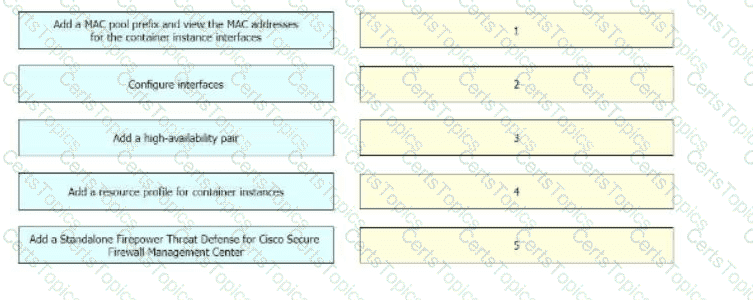
An engineer wants to perform a packet capture on the Cisco FTD to confirm that the host using IP address 192 168.100.100 has the MAC address of 0042 7734.103 to help troubleshoot aconnectivity issue What is the correct tcpdump command syntax to ensure that the MAC address appears in the packet capture output?
Which two types of objects are reusable and supported by Cisco FMC? (Choose two.)
What is the advantage of having Cisco Firepower devices send events to Cisco Threat response via the security services exchange portal directly as opposed to using syslog?
Which two statements about bridge-group interfaces in Cisco FTD are true? (Choose two.)
Which command must be run to generate troubleshooting files on an FTD?

Refer to the exhibit. An engineer must import three network objects into the Cisco Secure Firewall Management Center by using a CSV file. Which header must be configured in the CSV file to accomplish the task?
An organization has implemented Cisco Firepower without IPS capabilities and now wants to enable inspection for their traffic. They need to be able to detect protocol anomalies and utilize the Snort rule sets to detect malicious behaviour. How is this accomplished?
An engineer must implement Cisco Secure Firewall transparent mode due to a new server recently being added that must communicate with an existing server that is currently separated by the firewall. Which implementation action must be taken next by the engineer to accomplish the goal?
IT management is asking the network engineer to provide high-level summary statistics of the Cisco FTD appliance in the network. The business is approaching a peak season so the need to maintain business uptime is high. Which report type should be used to gather this information?
A network administrator notices that remote access VPN users are not reachable from inside the network. It is determined that routing is configured correctly, however return traffic is entering the firewall but not leaving it What is the reason for this issue?
A network administrator is trying to configure an access rule to allow access to a specific banking site over HTTPS. Which method must the administrator use to meet the requirement?
An engineer must deploy a Cisco FTD device. Management wants to examine traffic without requiring network changes that will disrupt end users. Corporate security policy requires the separation of management traffic from data traffic and the use of SSH over Telnet for remote administration. How must the device be deployed to meet these requirements?
Which command is entered in the Cisco FMC CLI to generate a troubleshooting file?
An engineer integrates Cisco FMC and Cisco ISE using pxGrid. Which role is assigned for Cisco FMC?
Which action should be taken after editing an object that is used inside an access control policy?
A Cisco FMC administrator wants to configure fastpathing of trusted network traffic to increase performance. In which type of policy would the administrator configure this feature?
An administrator is adding a new URL-based category feed to the Cisco FMC for use within the policies. The intelligence source does not use STIX. but instead uses a .txt file format. Which action ensures that regular updates are provided?
A network administrator wants to block traffictoa known malware site all subdomains while ensuring no packets from any internal client are sent to that site. Which type of policy must the network administrator use to accomplish this goal?
An engineer is implementing Cisco FTD in the network and is determining which Firepower mode to use. The organization needs to have multiple virtual Firepower devices working separately inside of the FTD appliance to provide traffic segmentation Which deployment mode should be configured in the Cisco Firepower Management Console to support these requirements?
A network administrator is reviewing a monthly advanced malware risk report and notices a host that Is listed as CnC Connected. Where must the administrator look within Cisco FMC to further determine if this host is infected with malware?
A network administrator is concerned about (he high number of malware files affecting users' machines. What must be done within the access control policy in Cisco FMC to address this concern?
An analyst is reviewing the Cisco FMC reports for the week. They notice that some peer-to-peer applications are being used on the network and they must identify which poses the greatest risk to the environment. Which report gives the analyst this information?
A network engineer must provide redundancy between two Cisco FTD devices. The redundancy configuration must include automatic configuration, translation, and connection updates. After the initial configuration of the two appliances, which two steps must be taken to proceed with the redundancy configuration? (Choose two.)
When using Cisco Threat Response, which phase of the Intelligence Cycle publishes the results of the investigation?
Refer to the exhibit.

A Cisco Secure Firewall Threat Defense (FTD) device is deployed in inline mode with an inline set. The network engineer wants router R2 to remove the directly connected route M 68.1.0/24 from its routing table when the cable between routed R1 and the Secure FTD device Is disconnected. Which action must the engineer take?
1
An engineer is setting up a new Firepower deployment and is looking at the default FMC policies to start the implementation During the initial trial phase, the organization wants to test some common Snort rules while still allowing the majority of network traffic to pass Which default policy should be used?
An engineer is configuring a custom application detector for HTTP traffic and wants to import a file that was provided by a third party. Which type of flies are advanced application detectors creates and uploaded as?
Which two routing options are valid with Cisco Firepower Threat Defense? (Choose two.)
In a Cisco AMP for Networks deployment, which disposition is returned if the cloud cannot be reached?
A mid-sized company is experiencing higher network bandwidth utilization due to a recent acquisition The network operations team is asked to scale up their one Cisco FTD appliance deployment to higher capacities due to the increased network bandwidth. Which design option should be used to accomplish this goal?
An organization has seen a lot of traffic congestion on their links going out to the internet There is a Cisco Firepower device that processes all of the traffic going to the internet prior to leaving the enterprise. How is the congestion alleviated so that legitimate business traffic reaches the destination?
An administrator is configuring their transparent Cisco FTD device to receive ERSPAN traffic from multiple switches on a passive port, but the Cisco FTD is not processing the traffic. What is the problem?
Which action must be taken to configure an isolated bridge group for IRB mode on a Cisco Secure Firewall device?
A network administrator notices that SI events are not being updated The Cisco FTD device is unable to load all of the SI event entries and traffic is not being blocked as expected. What must be done to correct this issue?
An engineer is configuring two new Cisco Secure Firewall Threat Defense devices to replace the existing firewalls. Network traffic must be analyzed for intrusion events without impacting the traffic. What must the engineer implement next to accomplish the goal?
Which action must be taken on the Cisco FMC when a packet bypass is configured in case the Snort engine is down or a packet takes too long to process?
An engineer configures a network discovery policy on Cisco FMC. Upon configuration, it is noticed that excessive and misleading events filing the database and overloading the Cisco FMC. A monitored NAT device is executing multiple updates of its operating system in a short period of time. What configurationchange must be made to alleviate this issue?
An engineer must change the mode of a Cisco Secure Firewall Threat Defense (FTD) firewall in the Cisco Secure Firewall Management Center (FMC) inventory. The engineer must take these actions:
• Register Secure FTD with Secure FMC.
• Change the firewall mode.
• Deregister the Secure FTD device from Secure FMC.
How must the engineer take FTD take the actions?
How should a high-availability pair of Cisco Secure Firewall Threat Defense Virtual appliances be deployed to Cisco Secure Firewall Management Center?
A network engineer sets up a secondary CiscoFMC that is integrated with Cisco Security Packet Analyzer What occurs when the secondary CiscoFMC synchronizes with the primary Cisco FMC?
An engineer must export a packet capture from Cisco Secure Firewall Management Center to assist in troubleshooting an issue an a Secure Firewall Threat Defense device. When the engineer navigates to URL for Secure Firewall Management Center at:
..
An engineer receives a 403: Forbidden error instead of being provided with the PCAP file. Which action resolves the issue?
An engineer must investigate a connectivity issue from an endpoint behind a Cisco FTD device and a public DNS server. The endpoint cannot perform name resolution queries. Which action must the engineer perform to troubleshoot the issue by simulating real DNS traffic on the Cisco FTD while verifying the Snarl verdict?
An engineer is setting up a new Cisco Secure Firewall Threat Defense appliance to replace the current firewall. The company requests that inline sets be used and that when one interface in
an inline set goes down, the second interface in the inline set goes down. What must the engineer configure to meet the deployment requirements?
What is a valid Cisco AMP file disposition?
What is a behavior of a Cisco FMC database purge?
An administrator must use Cisco FMC to install a backup route within the Cisco FTD to route traffic in case of a routing failure with the primary route. Which action accomplishes this task?
An engineer must perform a packet capture on a Cisco Secure Firewall Threat Defense device to confirm the MAC address of the host using IP address 192.168.100.100 while troubleshooting an ARP issue. What is the correct tcpdump command syntax to ensure that the MAC address appears in the packet capture output?
An engineer is configuring Cisco Security Devices by using Cisco Secure Firewall Management Center. Which configuration command must be run to compare the CA certificate bundle on the local system to the latest CA bundle from the Cisco server?
An organization has a Cisco FTD that uses bridge groups to pass traffic from the inside interfaces to the outside interfaces. They are unable to gather information about neighbouring Cisco devices or use multicast in their environment. What must be done to resolve this issue?
A network administrator is configuring a site-to-site IPsec VPN to a router sitting behind a Cisco FTD. The administrator has configured an access policy to allow traffic to this device on UDP 500, 4500, and ESP VPN traffic is not working. Which action resolves this issue?
What is a feature of Cisco AMP private cloud?
An organization has a Cisco IPS running in inline mode and is inspecting traffic for malicious activity. When traffic is received by the Cisco IRS, if it is not dropped, how does the traffic get to its destination?
A security engineer is adding three Cisco FTD devices to a Cisco FMC. Two of the devices have successfully registered to the Cisco FMC. The device that is unable to register is located behind a router that translates all outbound traffic to the router's WAN IP address. Which two steps are required for this device to register to the Cisco FMC? (Choose two.)
A network engineer detects a connectivity issue between Cisco Secure Firewall Management Center and Cisco Secure Firewall Threat Defense. Initial troubleshooting indicates that heartbeats and events are not being received. The engineer re-establishes the secure channels between both peers. Which two commands must the engineer run to resolve the issue? (Choose two.)
A connectivity issue is occurring between a client and a server which are communicating through a Cisco Firepower device While troubleshooting, a network administrator sees that traffic is reaching the server, but the client is not getting a response Which step must be taken to resolve this issue without initiating traffic from the client?
An engineer is creating an URL object on Cisco FMC How must it be configured so that the object will match for HTTPS traffic in an access control policy?
Which component is needed to perform rapid threat containment with Cisco FMC?
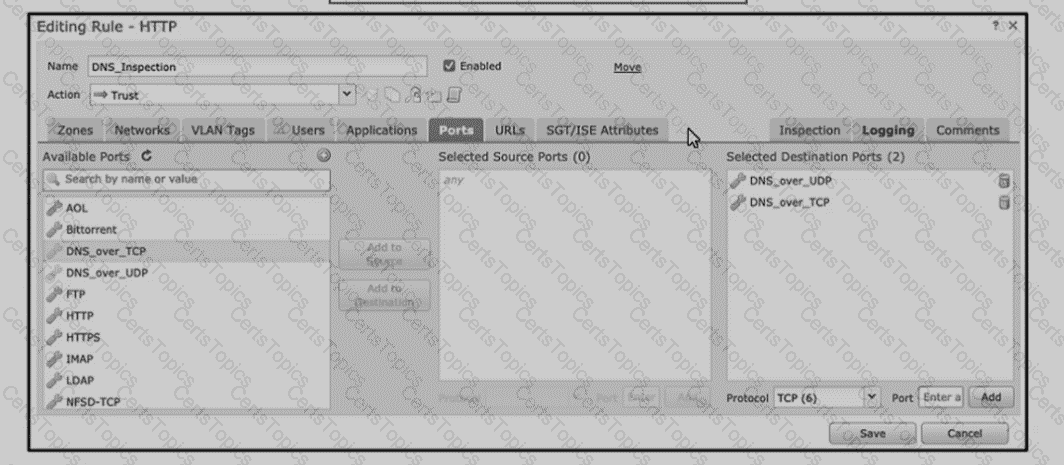
Refer to the exhibit An engineer is modifying an access control pokey to add a rule to inspect all DNS traffic that passes through the firewall After making the change and deploying thepokey they see that DNS traffic is not bang inspected by the Snort engine What is the problem?
Which two deployment types support high availability? (Choose two.)
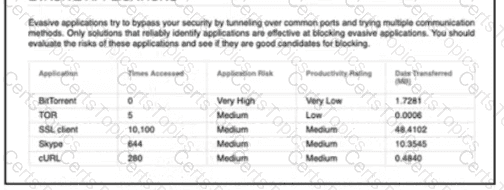
Refertothe exhibit. An engineer is analyzing a Network Risk Report from Cisco FMC. Which application must the engineer take immediate action against to prevent unauthorized network use?
An engineer is configuring a Cisco Secure Firewall Threat Defense device and warns to create a new intrusion rule based on the detection of a specific pattern in the data payload for a new zero-day exploit. Which keyword type must be used to add a Line that identifies the author of the rule and the date it was created?
An engineer is integrating Cisco Secure Endpoint with Cisco Secure Firewall Management Center in high availability mode. Malware events detected by Secure Endpoint must also be
received by Secure Firewall Management Center and public cloud services are used. Which two configurations must be selected on both high availability peers independently? (Choose two.)
Upon detecting a flagrant threat on an endpoint, which two technologies instruct Cisco Identity Services Engine to contain the infected endpoint either manually or automatically? (Choose two.)
An engineer currently has a Cisco FTD device registered to the Cisco FMC and is assigned the address of 10 10.50.12. The organization is upgrading the addressing schemes and there is a requirement to convert the addresses to a format that provides an adequate amount of addresses on the network What should the engineer do to ensure that the new addressing takes effect and can be used for the Cisco FTD to Cisco FMC connection?
An engineer must investigate a connectivity issue and decides to use the packet capture feature on Cisco FTD. The goal is to see the real packet going through the Cisco FTD device and see the Snort detection actions as a part of the output. After the capture-traffic command is issued, only the packets are displayed. Which action resolves this issue?
An engineer is deploying a Cisco Secure Firewall Management Center appliance. The company must send data to Cisco Secure Network Analytics appliances. Which two actions must the engineer take? (Choose two.)
Which two statements about deleting and re-adding a device to Cisco FMC are true? (Choose two.)
An organization is setting up two new Cisco FTD devices to replace their current firewalls and cannot have any network downtime During the setup process, the synchronization between the two devices is failing What action is needed to resolve this issue?
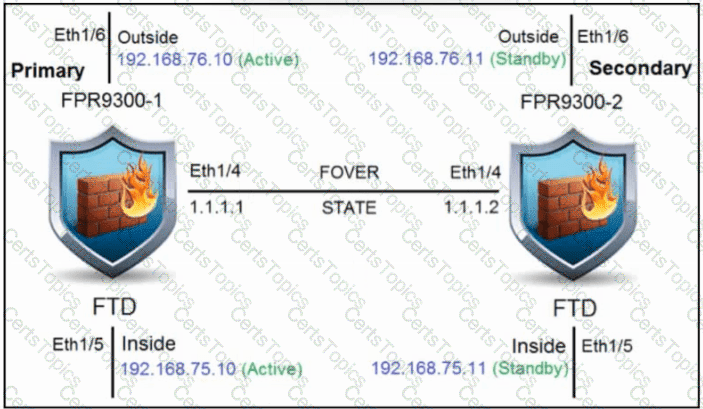
Refer to the exhibit. An engineer is configuring a high-availability solution that has the hardware devices and software versions:
two Cisco Secure Firewall 9300 Security Appliances with FXOS SW 2.0(1.23)
software Cisco Secure Firewall Threat Defense 6.0.1.1 (build 1023) on both appliances
one Cisco Secure Firewall Management Center with SW 6.0.1.1 (build 1023)
Which condition must be met to complete the high-availability configuration?
An engineer must integrate a thud-party security Intelligence teed with Cisco Secure Firewall Management Center. Secure Firewall Management Center is running Version 6.2 3 and has 8 GB of memory. Which two actions must be taken to implement Throat Intelligence Director? (Choose two.)
An engineer is troubleshooting connectivity to the DNS servers from hosts behind a new Cisco FTD device. The hosts cannot send DNS queries to servers in the DMZ. Which action should the engineer take to troubleshoot this issue using the real DNS packets?
An engineer defines a new rule while configuring an Access Control Policy. After deploying the policy, the rule is not working as expected and the hit counters associated with the rule are showing zero. What is causing this error?
An engainermust add DNS-specific rules to me Cisco FTD intrusion policy. The engineer wants to use the rules currently in the Cisco FTD Snort database that are not already enabled but does not want to enable more than are needed. Which action meets these requirements?
Which two features of Cisco AMP for Endpoints allow for an uploaded file to be blocked? (Choose two.)
What is the advantage of having Cisco Firepower devices send events to Cisco Threat Response via the security services exchange portal directly as opposed to using syslog?
When a Cisco FTD device is configured in transparent firewall mode, on which two interface types can an IP address be configured? (Choose two.)